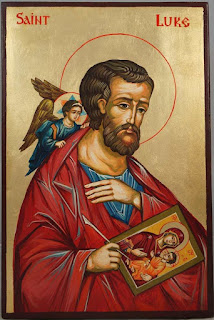The Assumption of the Blessed Virgin, Saturday 15 August 2020
‘Hail
to thee O Queen of Heaven, Alleluia.’
(Words
from the hymn ‘Regina Caeli’)
Today the Church celebrates the Feast of
the Assumption of the Blessed Virgin. Here assumption is not, as one wag put it
to me, something she erroneously believed, but rather her being taken bodily
into heaven at the point of her death. (She is it he first human, after Christ,
to be resurrected into eternal life – all others preceding her, those like
Lazarus we read about in the Bible, had been resurrected back to life, but would
eventually die.) In Orthodoxy this Feast is called the Dormition, or falling
asleep of the Blessed Virgin, as they believe that she did not die, but was
taken into heaven prior to her death, many Catholics see her as having died,
and thus her Assumption is also her resurrection.
[One of my favourite legends surrounding
the Assumption is the story of the arrival of the Apostles to the deathbed of
the Blessed Virgin. (Mary is the Mother of the Church, having been placed into
the care of the Beloved Apostle at the Crucifixion, John 19.26-27.) The
Apostles had been sent by the Holy Spirit across the world to spread the Gospel
message, and were miraculously transported on clouds, so the legend tells us,
to where Mary was. Following their arrival an argument broke out between Ss.
Peter and Paul over who should lead the Apostles in prayer. Each said the other
should do it: Paul that Peter should do it, Jesus having made him the head of
the Church; Peter that Paul should, because he was the greatest of the
Apostles. Following this the Blessed Virgin died, and was assumed (that is was resurrected
and immediately ascended into heaven, there to sit enthroned as Queen of Heaven
and Empress of Hell, the latter being a medieval title no longer in common usage.]
The status of the Blessed Virgin Mary
has long been a source of contention for Christians. Is she just a woman who
bore Jesus in her womb, or is she something more? Should we venerate her and
hold her in high esteem, or should we treat her like we would any other
historical figure, as a point of interest, but not someone to become too
excited about? [It’s not something I can decide for you, but I have come to the
conclusions I have through study and reflection.]
For me Mary plays an important part in
my faith. As the mother of Jesus (God) she has a particular place in the story
of salvation, one that goes beyond bearing Jesus in her womb, and makes her the
mirror of her ancestor Eve. Mary like Eve says yes, but not to a serpent, but
to God, she is thus the second Eve. But to be the second Eve she must, like
Eve, be without sin, hence we the doctrine of the Immaculate Conception which
teaches that Mary was born without sin. (That is not to say that she was not
born out of human sexual action, though even in this her conception was
miraculous, as her mother, St Anne were well past the age of childbearing when
she was conceived.)
She is called by the Catholic Church, ‘the
ever virgin’ or she is a perpetual virgin, that is following the birth of
Christ she remained a virgin until her death. This can seem somewhat strange to
our Anglican eyes, but there is sound tradition and historical reasoning to
support this. Ancient tradition tells us that when they were betrothed, Joseph
was already an old man with children, this accounts for the so called ‘brothers
and sisters of Jesus’ mentioned in the Gospels. As to her perpetual
virginity, Adam was created without human intervention, and so Jesus was
conceived by the action of the Holy Spirit and Mary’s ‘yes’ to the Angel. And
it was not uncommon in the Judaism of the time for a couple to abstain from
sexual intercourse. Mary and Joseph, tradition tells us took such a vow.
[All of these things can be found in the
teaching of the early Church, and that of the Church Fathers, and have been
believed by Christians and the church more widely for countless generations.]
When we come to the Assumption of the
Blessed Virgin, it is a reminder that since ancient times we have had no known
tomb of the Blessed Virgin, and whilst there are in the possession of various
churches some of her possessions (relics), there are no relics of her body, as
there are for the Apostles. It is a reminder that at her death, Mary was taken
bodily into Heaven (her Assumption), where she is there enthroned as Queen of
Heaven where she intercedes on our behalf, as do all the saints. A reminder
that just as we’d ask a friend for their prayers if we are sick or in need, so
we can ask the saints for theirs, and they who are caught up in eternity, have
all the time necessary to pray for each of our intentions and needs.
- - ‘Holy Mary,
mother of God, pray for us sinners now and at the hour of our death. Amen.’ (From the ending of the Hail Mary.)


Comments
Post a Comment